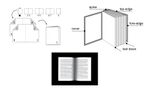User:Simon/Reprinting: Difference between revisions
| Line 11: | Line 11: | ||
Image: (clockwise from top left): imposition from a single-page PDF into a booklet, anatomy of a book, a spread | Image: (clockwise from top left): imposition from a single-page PDF into a booklet, anatomy of a book, a spread | ||
Snippets: [[../Trim4/Michaels booklet script for PDF imposition]] | Snippets: | ||
* [[../Trim4/Michaels booklet script for PDF imposition]] | |||
[[Category:Tasks of the Contingent Librarian|reprinting]] | [[Category:Tasks of the Contingent Librarian|reprinting]] | ||
Revision as of 20:00, 8 June 2020
reprinting
see also being kind to the reader, bootlegging, rebinding, republishing
Making a printed book involves selection of paper stock and decisions on how to economise with the printing method. Often this calls for text to be imposed, 2-up, double-sided, into a booklet. Booklets are useful for thin, staple-bound books, less than 64 pages of ordinary 80gsm paper.
A text block of 2-up imposed spreads is cut in the middle first, then the two halves are joined together like a sandwich. Turning a single page document into a 2-up imposed PDF also imposes a constraint. There is no other way to create the text block. So, a book made in this way will result in a visible “split”, and the pages will naturally fall open where the two halves were joined.
This is because most commercially bought paper comes with the grain direction aligned with the long edge, not the short edge. The solution is to print pages, not spreads, 1-up, double sided on a page. If you can find a printer that takes sheets of paper smaller than A4 (such as A5) this is perfect, if not, you may have to concede the loss that comes from trimming down to a smaller than A5 size. Although this may seem just a superficial concern, the book will not be split, making for a materiality that emphasises the unity of the text.
Image: (clockwise from top left): imposition from a single-page PDF into a booklet, anatomy of a book, a spread
Snippets:

